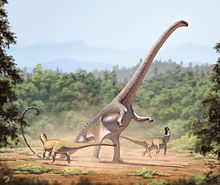Ardetosaurus
Ardetosaurus is an extinct genus of diplodocid sauropod dinosaurs from the Late Jurassic (Kimmeridgian) Morrison Formation of northern Wyoming, United States.
It was first described in 2024 on the basis of a partial articulated skeleton, including vertebrae from the neck, back, and tail, hip bones, and part of the left hindlimb.
In 1989, Hans-Jakob Siber and workers from the Aathal Dinosaur Museum revisited this location, finding another site later named the Howe-Stephens Quarry.
The fossil—originally identified as belonging to the genus Diplodocus—was given the nickname "Brösmeli", meaning "crumbly" in Swiss German, and sent to Europe for preparation and eventual study.
The Oertijdmuseum also purchased four other diplodocoid specimens, nicknamed "Aurora", "Triplo", "Twin", and "XL", found in the same quarry as Brösmeli.
[2] Once Brösmeli, Triplo, and Twin were fully prepared, the museum organized a mounted composite skeleton based on these specimens, which was completed in March 2022.
[2] In 2024, van der Linden et al. described Ardetosaurus viator as a new genus and species of diplodocine sauropods based on MAB011899, the holotype specimen.
The specific name, viator, is the Latin word for traveler, referring to the long journey the specimen has gone through to arrive in the Netherlands.
Members of this family have thin, cylindrical pencil-like teeth confined to the front of their jaws that may have assisted the animals in effectively stripping leaves from branches.
The maturity of this specimen is indicated by the presence of an external fundamental system (EFS), which is a band of tissue that only develops when bone growth slows in older animals.
[11] Ardetosaurus is a diplodocine sauropod, placing it among several taxa that also lived in the Morrison Formation including Diplodocus, Galeamopus and Supersaurus.
[5] Amphicoelias altus Apatosaurinae Unnamed species Tornieria africana Supersaurus lourinhanensis Supersaurus vivianae Leinkupal laticauda Galeamopus hayi Diplodocus carnegii Diplodocus hallorum Kaatedocus siberi Barosaurus lentus Ardetosaurus is known from the Morrison Formation, a rock sequence with outcrops throughout the western United States known for its rich dinosaur fauna.
[14] The ancient Morrison Basin region, where many dinosaurs lived, ranged from Alberta and Saskatchewan in the north to New Mexico in the south.
In particular, the Howe-Stephens Quarry from which Ardetosaurus is known has yielded associated skeletons of the sauropods Diplodocus and Camarasaurus, the armored Stegosaurus, the theropod Allosaurus and the small herbivorous Nanosaurus.
[17] Non-dinosaurian animals in the Morrison Formation include pterosaurs (Harpactognathus, Kepodactylus, Mesadactylus, and Utahdactylus), in addition to many ray-finned fishes, amphibians, turtles, sphenodontians, lizards, terrestrial and aquatic crocodylomorphs, and various small mammals.







